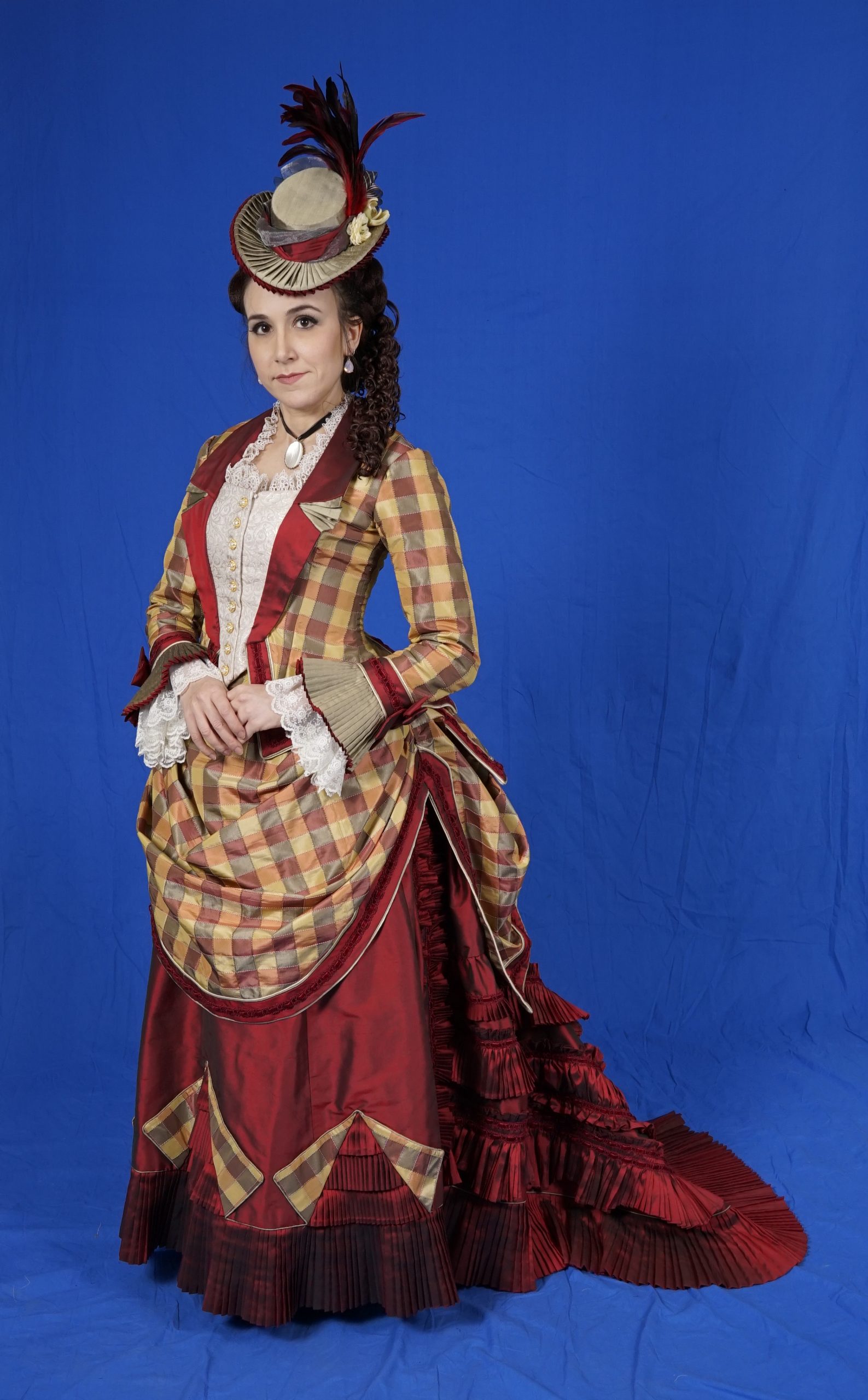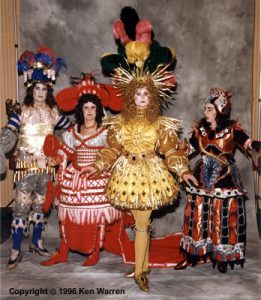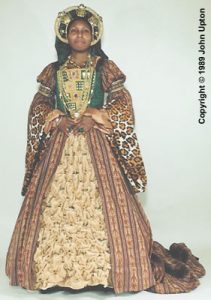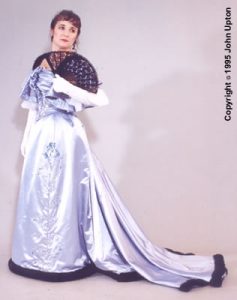CC34-H-29k3: What Would Miss Fisher Wear?
CC34-H-29k3: What Would Miss Fisher Wear? | Division: Master | Category: Historical Dress | Designer(s): Laura Ulak, Jackie Anelbano-Bongard, Dana Baird, Erin Schneider, Shelly Kumar, Amanda Nerud, Gregory Laffrenzen, Audrey Caseltine, Melisa Ferns, Erica Ramisch, Karen Huse, Artemisia Moltabocca, Glynnis Vance, Lindsey Marth, Gilah Maashal and Chelsey Markfort | Maker(s): Laura Ulak, Jackie Anelbano-Bongard, Dana Baird, Erin Schneider, Shelly Kumar, Amanda Nerud, Gregory Laffrenzen, Audrey Caseltine, Melisa Ferns, Erica Ramisch, Karen Huse, Artemisia Moltabocca, Glynnis Vance, Lindsey Marth, Gilah Maashal and Chelsey Markfort | Presenter(s): Karen Huse | Presentation Award(s): BIS Overall (Photo ID: Scott Johnson, Realtime Portrait Studio | Event Date: 2016)
Competition Staff & Rules
Staff:
- Director: Jamie Butler
- Master of Ceremonies: Vicky Assarattanakul
- Presentation Judges: Phillip Gust, Kathe Gust and Catherine Cherwin
- Judges’ Clerk: Unknown
Rules:
Historical Masquerade
The Sunday night masquerade is dedicated to historical costumes — the celebration of all past time periods through clothing. Categories traditionally include historical reproductions, historically-inspired garments, and ethnic dress. The Historical Director will determine the cut-off limit for time periods and announce it with the rules.
An entrant can expect slightly different types of judging; workmanship judging will be done by appointment and you do not need to be wearing the costume; stage presentation judging includes how the costume looks on you as well as the performance. There is also separate judging for your documentation detailing the research and historical information about your costume. Entrants must be attending members of Costume-Con 34.
Your director for the Historical Masquerade will be Jamie Butler of the Madison Area Costuming Society.
Rules for the Historical Masquerade
The Costume-Con 34 Historical Masquerade celebrates the history of costume, including all cultures, periods, and types of dress. It recognizes creativity, scholarship, stage presentation, and workmanship skills in the context of historical clothing. “Historical costume” is costume based on clothing that was worn or could have been worn somewhere in the world through the end of the year 1966. Anything in the years 1967 and after will not be accepted into the Historical Masquerade unless it falls under the Ethnic Costume/Dress category. These rules for the Historical Masquerade follow the International Costumers’ Guild Guidelines for Ensuring Fair Competition. Please read them carefully; while similar to those for other masquerades, they are not identical to them.
I. Competition Categories
The Historical Masquerade will have four categories of entry:
- Historical Recreation
- Historical Dress,
- Historical Interpretation, and
- Ethnic Costume or Dress.
Entries in all categories are eligible for Best in Class and Best in Show.
Category Definitions:
Historical Recreation is for a costume that is based on an existing garment, statue, painting, description, or illustration. The goal of a Historic Reproduction is to re-make a costume that existed in the historical time period (no later than 1966).
Historical Dress is for a costume that is intended to look like it came from a particular period of history. This includes original costumes meant to look as if they were designed and made in a particular period. It is acceptable to use modern approximates for period materials for reasons of availability, cost, or safety; these approximations should be noted in documentation. Modern machine sewing is allowed.
Historical Interpretation is for a costume that intentionally and visibly departs from the period on which it is based. It ought to be obvious to the viewer that this costume was not intended to be totally authentic. If the judges have to ask what makes your costume an interpretation, it probably belongs in Historical Dress.
The distinction between these two categories is based on the costume’s intent, not its execution.
Ethnic Costume or Dress may be of any period (including the present). Ethnic means “of or pertaining to a religious, racial, national, or cultural group.” Any costume that would fall into any religious, racial, national, or cultural group may be entered as Ethnic Costume or Dress. If an ethnic garment is from the past and no longer worn by any of the above-listed groups under the definition of Ethnic, the entry may still be considered Ethnic Costume. This category is one of reproduction, NOT interpretation. Therefore, your requirements for design and creation techniques (e.g., sewing), choices of materials, and documentation will be the same as Historical Dress entries.
If you are not sure your costume idea fits into any of these categories, or if you are concerned it may not be appropriate for the Historical Masquerade, please ask the Director!
II. Skill Divisions
A contestant may enter at a level higher than the one for which he or she qualifies. However, an entrant who then wins at that level may not subsequently compete at a lower level. If in doubt over the level at which to compete, consult the Director.
Group entries should compete at the level of the group’s most experienced member who is an essential element of the entry. If in doubt, consult the Masquerade Director.
Skill Level Definitions: Skill levels are intended to ensure that both novice and experienced costumers have a reasonably equal chance to win awards.
Young Fan: This level is limited to entrants younger than 13 years of age on May 8th, 2016 (i.e., born after May 8th, 2003) who are not part of an adult entry. It will be divided between entries made by a young fan and entries made by an adult that a young fan presents.
Novice: The Novice level is to encourage beginners. You may not enter at this level if you
- have won two awards at the Novice level in a Costume-Con historical masquerade,
- have won at a level higher than Novice in a Costume-Con historical masquerade,
- compete at the Master level in science fiction and fantasy masquerades at Costume-Cons, Anime North, or World Science Fiction Conventions (ICG-recognized “international-level competitions”),
- have a costume Laurel, or
- are a professional. Professional is defined as someone who earns a majority of his or her income from fashion or costume, including university faculty members.
Journeyman: The Journeyman level is an intermediate level to allow further development of costuming skills. You may not enter at this level if, at a Costume-Con historical masquerade, you
- have won four awards at the Journeyman level,
- have won an award at the Master level,
- have won Best in Show, or if you
- have a costume Laurel or
- are a historic costume professional (as defined above).
Master: This is an open level. Anyone may enter. You must enter at this level if you are not eligible to enter as a Young Fan or at the Novice or Journeyman levels.
III. Rules
All the general costume, prop, and weapon rules for Costume-Con 34 will apply.
- The Historical Masquerade will limit entries to costumes based on clothing that was worn, or could have been worn, through 1966. You must be an attending member of Costume-Con 34 to compete in the Historic Masquerade, as must any models you may use.
- Each contestant may appear only once on stage. You may enter another costume, but it must be on another Costume-Con 34 member’s body.
- No purchased or rented costumes may compete. If you have an interesting costume you think the audience might enjoy that is purchased you may only show it in Exhibition. Exhibition costumes do not require documentation or workmanship judging but are not eligible for awards.
- The historical masquerade is rated PG-13. No flagrant nudity — there must be some display of skill in creating and executing a design. The Judges will not award what Mother Nature created. Remember, no costume is no costume.
- Costumes that have won major awards (excluding Honorable Mention) at previous Anime North, Costume-Con, or Worldcon competitions are ineligible to compete for an award, but may appear Out of Competition (Exhibition). Costumes which have won major awards at a lower skill level at smaller conventions must be entered at the next highest skill level, and/or with significant changes made to the costume. No sandbagging to collect multiple major awards.
- There is no prohibition against presenting costumes worn in the halls before the show however we do strongly discourage it. We encourage you to surprise the audience with your costume.
- There will be absolutely no flame, fires, sparks, or other flaming on stage. Other special effects must be clearly described to the Masquerade Director at the tech rehearsal in order for us to determine that they are legal and safe. Costumes with electric power requirements must be self-contained — no extension cords. We discourage the use of radio controlled or other wireless devices as part of an entry, as it may not work inside the convention center.
- All entries will be allowed 1 minute (60 seconds) on stage. You may use less time than this, but 60 second is the max. Groups larger than 7 people may have extra time. Going over this time limit requires approval of the masquerade director.
- No live animals (other than guide animals) may be used in the masquerade.
- Small children must be under the control of a responsible adult at all times (back stage as well as on stage).
- Weapons: the Masquerade Director must clear all weapon props and your routine at tech rehearsal. No sharp edges or points will be permitted. Weapons that shoot or eject projectiles will not be permitted. Do not point weapons at the audience or judges directly.
- Entrants may not throw anything at the audience. Dropping items on stage are allowed, however, following a presentation the entrant(s), roadies, or ninjas must remove props left on stage quickly and easily.
- Entrants may not use messy substances, wet, dry, sparkly, or oily, which may ruin other costumes, on stage or in the green room. This is generally known as the “No Peanut Butter” rule.
- There will be no microphones available to entrants; you must pre-record any dialogue and all music. You may submit text for the MC to read before, during, or after your presentation; this text will be vetted during tech rehearsal to make sure it complies with all rules.
- All entries are provided backstage assistance as needed. If you need particular help getting up and down the stairs, moving props on and off stage, etc, please inform the director prior to tech rehearsal.
- Entrants will be required to attend a tech rehearsal. Entrants who do not participate in the tech rehearsal will be disqualified. You need not wear costumes for the tech rehearsal; however, you should wear the shoes you will use for your presentation and any parts of your costume that will impede your movement or vision, or both.
- Your costume must be completed before you get to the Green Room. No major construction work may take place in the Green Room except the final assembly of large costumes and props or unexpected repairs.
- All entrants must check into the green room by the required call time or you will be disqualified. The green room and back stage area are intended for entrants, handlers, and masquerade staff only. Friends or family are not allowed except in extreme emergencies.
- The Masquerade Director has the full authority to eliminate anyone from the competition on the grounds of bad taste, danger to self and/or others, violation of the above rules, or any other reason deemed sufficient. There is no appeal.
- Do NOT surprise the Masquerade Director and crew. If you are planning something unusual or unique, please inform the Masquerade Director and work with them to surprise and astound the audience.
- If you feel any or all of these rules don’t apply to you, you are wrong. You must convince the Masquerade Director to make an exception long before the masquerade.
IV. Workmanship judging
This is your opportunity to let the judges admire your work up close. Each entry will meet by itself with the panel of judges to show off the costume. Entrants will be expected to show the judges all necessary parts of the costume. If there is an item or element of the costume you want the judges to note especially, be prepared to point it out to them. We recommend that you bring the costume to the prejudging, rather than wear it, so that the judges may handle and examine your work inside and out. However, if you decide to wear the costume to prejudging, be prepared to have the judges look down your cleavage, under your skirt, or at your underwear.
This part of the competition is required of all entrants. Prejudging time will be strictly limited, usually to 5-10 minutes per entry. The schedule will depend on the number of entries received by close of registration. Contestants will have an opportunity to sign up in advance at the masquerade registration desk for appointments with the judges.
V. Documentation judging
Every entry must have some documentation. Documentation must be turned in to the masquerade registration desk by the closing of the table Saturday afternoon. If you are arriving at the con later, please contact the director well in advance.
Basic documentation. The basic requirements include:
- Title of costume
- Entry category
- Name and address of the person responsible for the entry (or spokesperson for a group)
- Name(s) of designer(s) and maker(s)
- Brief identifying description of the costume’s historical period, geographic origin, social class, and so forth
- Bibliography of sources
The “brief identifying description” should include evidence of the historical basis for the costume. This could be as little as one photocopy of a single picture with an identifying caption or it could be more comprehensive. Assume that the judges are not familiar with the costume(s). You may wish to begin with a brief statement of what you are trying to accomplish and your rationale for choosing the project.
Advanced documentation. In going beyond the minimal requirements, your documentation might include the following:
- Pattern sources
- Photocopies of visual sources, such as artworks, costume drawings, and sketches, that you used
- Rationale for design and for choices of fabrics and colors
- Swatches of fabric and trim
- Your own photograph(s) of original historical garments or accessories
- Brief descriptions of any special skills or tools you used, such as shoe-making, weaving, or welding
Outstanding documentation demonstrates a comprehensive knowledge of the historical source(s) on which a costume is based, with rationales for all elements of the costume, including undergarments, accessories, and minor details, and explanations for deviations from the norm of the period. Excellent documentation also is organized logically and neatly, and presented attractively. Some contestants even go to the length of designing documentation in a style consistent with the costume.
Length of documentation. Outstanding documentation is brief — long enough but no longer than you need to demonstrate the historical basis of the costume. Please be concise. Text (exclusive of bibliography and captions on illustrations) is limited to no more than five 8½”x11″ typed double-spaced pages per costume. (In a group entry, each costume may have up to five pages of text.) There is no page limit on captioned photographs and illustrations, fabric swatches or other samples, references, or bibliography. A caption need not be limited to only a few words. It may be a few sentences or even a brief paragraph.
The following will not be accepted as a part of documentation: original sources, including books and paintings (make copies), slides, computer files, videos (tape/CD/DVD), and files on phones.
VI. Additional Information
Sound: recordings may be submitted on CD or CD-R, or as an mp3 file on a USB drive, and should contain only the music and/or speech you want played and nothing else. Music must be handed in at the masquerade registration desk prior to your tech rehearsal. We strongly recommend that you bring several copies of your recording, to provide a back-up should one fail.
Lights: The default lighting will be stage dark, lights rise on entry, fade to black at exit; other patterns may be arranged with tech. We will update if additional lighting information or options become available.
Stage: Our official stage dimensions are 16 feet deep by 30 feet long. Default entrance will be stage left, default exit will be stage right. Plan on using stairs with non-removable handrails to enter/exit the stage. If a ramp is available, we will add that information when it becomes available. If you have mobility issues, please inform the director so accommodations can be made.
Awards: Our judges will make awards in three areas:
1. Documentation
2. Workmanship and Detail
3. Stage Presentation
The Historical Masquerade’s philosophy is “excellence deserves award;” there are no predetermined minimum or maximum number of awards the judges may make. The judges are not obliged to award Best in Class or Best in Show if, in their opinion, no entry meets the standards for those awards.
VII. Entry forms
Registration forms will be available at the convention. If we are able to put entry forms online, we will notify here. Pre-registration may not be done online at this time.
Tips for a Successful Masquerade
Before the show, get some sleep!
Before the show, please eat. If you want to faint after you’ve been on stage, fine; however, we don’t want you to pass out from hunger or low blood sugar in the Green Room or on stage.
Before the show, rehearse, rehearse, rehearse.
Remember, this is a costume show, not a talent competition. Never bore the audience.
Don’t forget to enjoy yourself. Have fun!
If you have any questions, please contact Jamie Butler – your Historical Masquerade Director at [Removed].
Awards (via Facebook):



